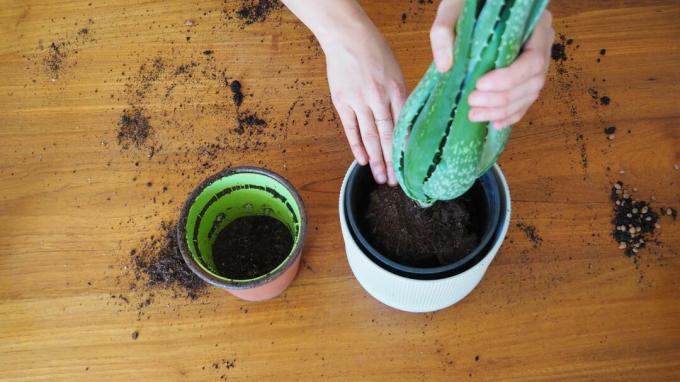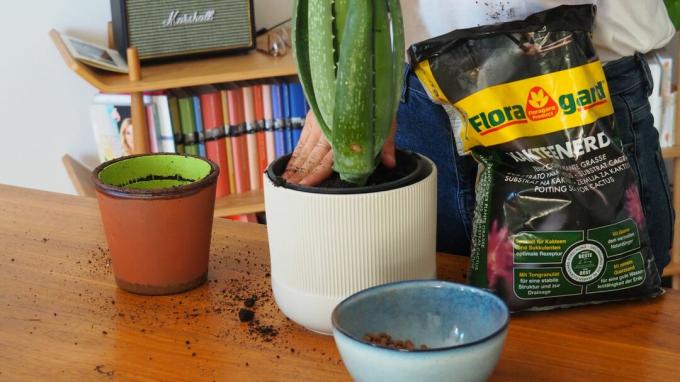The easy-care plants are suitable for indoors and outdoors. In our video we show how to properly repot succulents.
Video tutorial for repotting succulents [music: www.bensound.com]
Houseleek (Sempervivum), Money tree (Crassula ovata) or Aloe vera (Aloe vera) - many popular houseplants become the Succulents counted. No wonder, after all, the plants are considered to be particularly easy to care for and are particularly suitable for beginners. The reason for their robust character is the fact that succulents are characterized by the fact that they are excellent at storing water in their tissue. This means that the plants can withstand longer periods of drought without any problems. But also the undemanding Succulents need grooming every now and thenwhich is why it is worth repotting them every now and then.
contents
- When and how often do you have to repot succulents?
-
Repotting succulents: step-by-step instructions
- That’s what you need
- The right soil for succulents
- The perfect vessel for succulents
- How to repot succulents: instructions
- Care for succulents after repotting
- The perfect location for succulents
When and how often do you have to repot succulents?
Even if succulents don't need a lot of attention, they should still be repotted regularly. However, it is difficult to generalize at what intervals this should happen: Since the succulents are not botanical plant group, but only a collective term for water-storing plants, are hidden behind this Synonymous with numerous types of plants from the mini-succulent plant to the large cactus, some of which are strong in their growth differentiate. So it is not surprising that they are particularly vigorous Succulent species should be repotted up to once a year, while slow-growing species can stay in their pot for up to five years. On average, however, it is assumed that a succulent plant needs two to three years to root through its new pot, which is why this period of time is often given as a rule of thumb. Another indication that it is time to repot is when the plant hardly has any space left in the pot. However, it is worth repotting the succulent plant for the first time immediately after buying it: old or poor-quality substrate as well Unfortunately, soil-borne pests are not uncommon for house plants that are bought and can significantly improve the health of the plant without repotting restrict.

But not only the frequency, but also the timing is decisive when repotting: The beginning of spring is best around the easy-care houseplants to offer a new home. At this point, the succulents are at the beginning of their main growing season and will therefore thrive particularly well in the new pot. During the summer, however, you should not repot the plant, as the additional stress on the plant during its rapid growth is particularly problematic in summer. Winter is also not well suited for repotting, as the plants hardly develop new biomass in their resting phase and, accordingly, only slowly root through the new substrate.
Repotting succulents: step-by-step instructions
Even if succulents often grow slowly, they have to move to a different pot from time to time. You can find out what you need for this and how to properly repot succulents here.
That’s what you need
Repotting succulents isn't particularly difficult. In fact, most of the things you need for this can be found in your own household. To repot succulents you will need:
- Planter
- Saucer
- Planting clay
- Succulent or cactus soil
- Possibly gloves

The right soil for succulents
Succulents are considered true masters when it comes to storing water, because they are often found in particularly dry regions of the world. Plants, on the other hand, do not tolerate too much moisture in their substrate or even waterlogging - Your sensitive roots are quickly damaged here and the succulent can in the worst case enter. For this reason, it is particularly important to pay attention to the right plant substrate: a good one Drainability is one of the main aspects to consider when choosing the right soil should. Even too much nutrients are not good for the plant, which is why you should use a particularly poor, permeable soil for the succulents. Special succulent or cactus soils meet these requirements and can be purchased from specialist retailers.
Expert tip: If you want to know exactly what is in your potting soil, you can also lend a hand: Cactus soil can not only be bought, but also mix yourselfin order to adapt them perfectly to the needs of your own plants.
The perfect vessel for succulents
Theoretically, succulents can be grown in almost any container, because the frugal plants only have one requirement for their environment: there must be adequate drainage. However, succulents thrive best when planted in an ordinary saucer with a matching planter. This combination has the advantage that excess water can drain off through the holes in the saucer, so that the risk of waterlogging is minimized. If you like it a little more unusual, you can also combine the saucers with disused crockery or other unusual vessels in order to put the plants in the limelight. It is only important that the drainage holes in the saucers guarantee sufficient drainage of water.

How to repot succulents: instructions
Once you have found the right soil and the right container for your succulent plant, you can start repotting. First you start with the preparation of the new pot. To do this, the saucer is placed in the planter and filled about a quarter full with planting clay. This mainly ensures that the drainage properties of the substrate are further improved and there is no waterlogging. Now you fill a little of the cactus or succulent soil into the pot.

Now you can carefully remove the succulent from its old pot. Here you should especially with succulents with thorns or thorns, for example with the Cacti (Cactaceae), pay attention to your safety and wear thorn-proof gloves to avoid injuries. The old soil can be removed very carefully with your fingers. However, the fine roots of the succulent should not be damaged - only the soil that can be easily peeled off is removed.
The succulent plant is now placed in its new pot. This is filled with the special cactus soil, which should be pressed lightly with your fingers. Particularly with tall succulents, care must be taken that the plant is used as upright and straight as possible in order to give it the necessary stability within its new pot admit. Make sure to keep the previous planting depth - succulents planted too deeply can start to rot.
Here are all the steps again in quick succession:
1. Put saucer in planter
2. Fill the saucer a little less than a quarter with planting clay
3. Cactus or succulent soil fill in the pot
4. Carefully remove the succulent plant from the old pot
5. Carefully remove excess, old soil; Do not damage any roots if possible
6. Put the plant in a new pot
7. Fill the pot with soil and carefully press it down with your fingers

Care for succulents after repotting
Repotting means enormous stress for succulents - as for any other plant. For this reason, it is particularly important in the first time after repotting to give your plant enough care. In the first week after repotting, the succulents should not come into direct contact with full sun, as this is another stress factor for the plants. Instead, it is advisable that the succulents can first relax in partial shade. Succulents should also be watered directly after repotting. You should only water the succulent plant for the first time after about a week - if it is too early If the plants are watered, there is a possibility that the already stressed roots will rot kick off. If the first weeks after repotting have already passed, the Succulents well-groomed will be like before.
The perfect location for succulents
So that the succulent can present itself in full beauty, you should make sure to offer it a suitable location. Most species prefer a sunny, light place as possible - ideally directly at the south window. If the plants get too little light, this is quickly shown by an unnaturally long and stretched growth. Only in the first week after repotting you should not expose the plants to full sun. But there are also exceptions with succulents: Plants from the genera aloe (aloe), Haworthie (Haworthia) and Gasterie (Gasteria) do not tolerate a place in full sun and therefore prefer a place in partial shade.
It's not just succulents that need repotting. As is the case with you Cacti and carnivorous plants succeed, we reveal in our special articles.
Many thanks to Floragard for their support!



